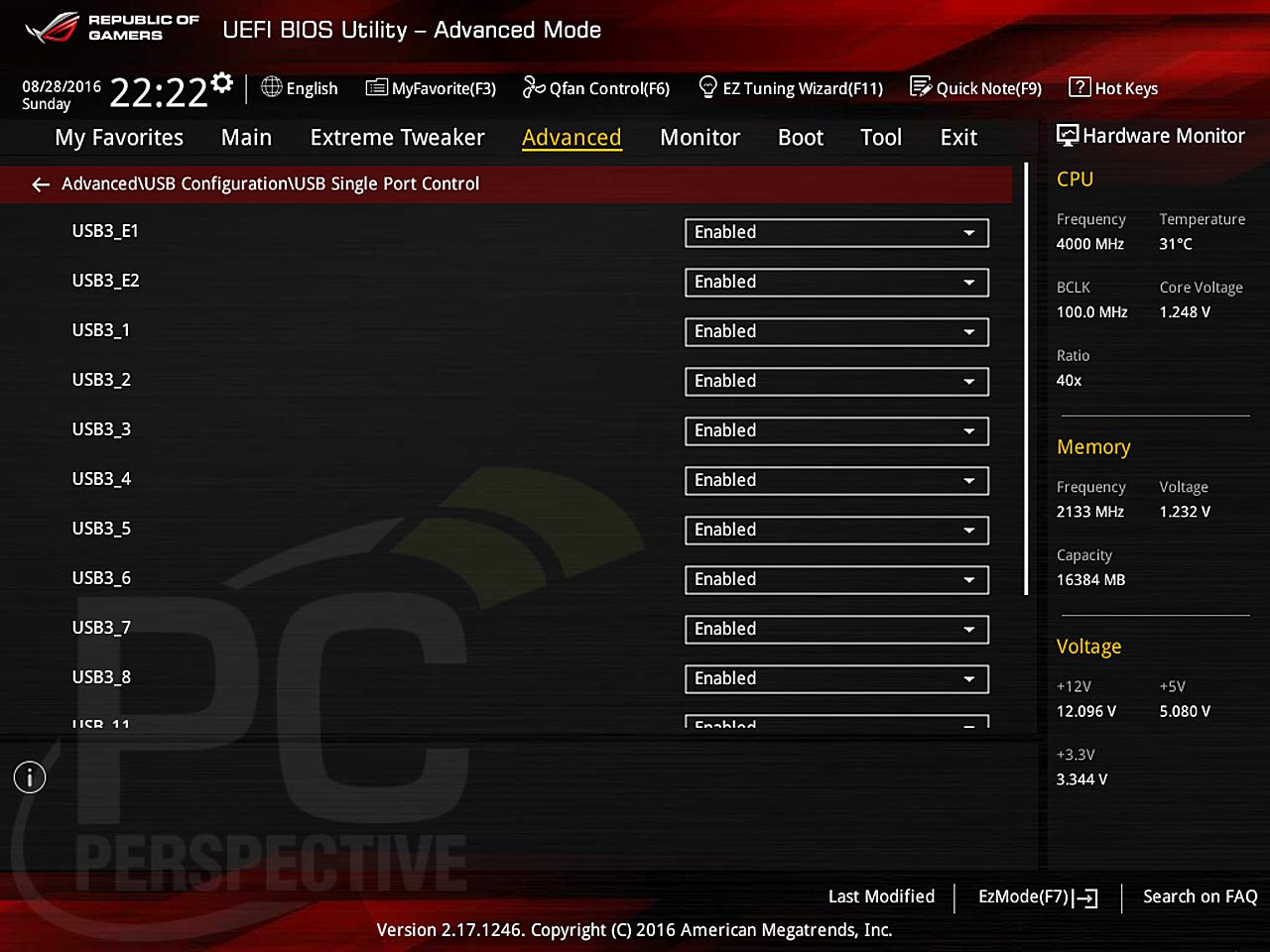UEFI Features continued, EZ and Advanced Modes
The following screens detail settings on the EZ Mode interface and Main and Advanced tabs in the Advanced Mode interface.
EZ Mode Interface
EZ Mode, Main page
EZ Mode, Language selection pull down
EZ Mode, Main page, non-English language
EZ Mode, Boot Menu popup
Advanced Mode Interface
Main tab
Main tab, System Language selection field
Language selection pull down
Main Tab, non-English language
EZ Tuning Wizard, OC Mode, Current System Configuration page
EZ Tuning Wizard, RAID Mode, Enable RAID mode page
Advanced tab
Advanced tab, CPU Configuration page
Advanced tab, CPU Configuration page continued
Advanced tab, CPU Configuration page, CPU Power Management Configuration page
Advanced tab, Platform Miscellaneous Configuration page
Advanced tab, System Agent (SA) Configuration page
Advanced tab, System Agent (SA) Configuration page, Graphics Configuration page
Advanced tab, System Agent (SA) Configuration page, DMI/OPI Configuration page
Advanced tab, System Agent (SA) Configuration page, PEG Port Configuration page
Advanced tab, ROG Effects page
Advanced tab, PCH Configuration page
Advanced tab, PCH Configuration page, PCI Express Configuration page
Advanced tab, PCH Storage Configuration page
Advanced tab, USB Configuration page
Advanced tab, USB Configuration page, USB Single Port Control page
Advanced tab, Onboard Devices Configuration page
Advanced tab, Onboard Devices Configuration page continued


































It needs ground effects.
It needs ground effects.
I have the V formula. I
I have the V formula. I wouldn’t buy again, no matter how much this seems to be upgraded. Poor build quality and I dont trust ASUS’ software.
$400 for a motherboard??? no
$400 for a motherboard??? no thanks
Just completed a build for a
Just completed a build for a customer and he was very satisfied with the performance and aesthetics of the MB especially the Aura. Personally i’m a fan of Asus products even though software sometimes buggy and all but overall good.
I’ve had this board for a few
I’ve had this board for a few months and I will probably never buy another “gaming” motherboard again. Here are my impressions:
– The included software is lackluster and clunky. All of it has a “tacked-on” feel. Fan Xpert is all I ever really use.
– The onboard audio is really not very good (I ended up using the optical output to connect to an external DAC).
– Overclocking performance (6700k on custom water with Dominator Platinum RAM) hasn’t been terrible, but also hasn’t been great. The silicon lottery strikes again, perhaps.
– Overall system stability was not very good at first, though it seems much better after the last couple of UEFI updates. Kudos to ASUS for the continued support.
– The onboard LED lighting is not very even at all. The armor does look super nice, though.
– The start-up status LEDs are covered by the 24-pin power supply cable and thus unreadable.
– No Thunderbolt? At this price point?
Honestly, my next build will probably be based around a workstation board. Going into the purchase, I was expecting the gaming features to be useful. Not really.
Agree with the AISuite
Agree with the AISuite software, the only really useful feature that works is the fanxpert, but this can all be set in UEFI. AISuite is buggy, support on it is very bad. some features dont work well, and had issues with anniversary update and compatibility. It also pings IP addresses in taiwan, probably update feature.
Agree with onboard audio, its “OK” but dedicated sound card to same crappy speakers, you can hear the difference, big time
Had the previous gen formula, no stability issues, but didnt overclock much with it, had it on water as well
Agree that Asus does a great job with keeping UEFI updates for their products
Their workstation motherboards are less gimmicky, and there really isnt a performance delta at all
Even FanXpert is rather
Even FanXpert is rather spotty sometimes. What I’d REALLY love to see is the CPU/VRM/PCH sensor voltages tied directly to headers so that you could skip all the flaky software altogether!
If there’s not a performance delta between the gaming boards and the workstation boards, I wonder if there’s a stability/longevity delta. If not, the extra cost of the workstation parts might not be justifiable.
Maybe the Sabertooth boards are a good compromise between the gaming and workstation lines?
Couple general questions
Couple general questions about your motherboard tests.
1. How do you go about testing the audio?
2. Do you test the board to see if the claims of the PCB isolation are true?
3. Are all the ports checked to see if they were grounded properly?
4. What amount of noise do you normally see on a board?
Thanks.
audio testing is done using a
audio testing is done using a 5.1 speaker system and headphones with MP3 tracks through Media Player for output tests and the headphone microphone for input tests. Testing is normally done using the ports integrated in to the rear panel.
Thanks for the reply. I
Thanks for the reply. I wanted to check to see if Pcper had any other way of validating the manufacturers claims after I recently discovered that ASRock had a defect in at least one of their board designs from a few years ago.
For most users (gamers and
For most users (gamers and otherwise), the integrated sound stuff is good enough or better. For the super audio-philes though, probably should go the add-in PCIe card route…
Sure, if someone wants higher
Sure, if someone wants higher fidelity audio a sound card or external DAC is always an option. However, as you said, if the motherboard manufacturers have done things right, the onboard sound should be good enough for the average user. When things aren’t done right, manufacturers end up with problems like noise on the ground because they cut corners and don’t have any tests in place to catch these problems.
This was the case with ASRock, and why I’m looking into how much scrutiny reviewers give onboard audio.
$360 uhhhh no thank you
$360 uhhhh no thank you
I like Asus MoBos but the
I like Asus MoBos but the current one I have the is IV Gene with z68 chipset. The thermal sensors that FanXpert uses were terrible. Way off the mark. I use HWMonitor to check temps and the UEFI’s fan profiles to set fan speed.
My question is this: Do the latest Asus boards use the more accurate temp sensors nowadays or the same old outdated ones like on my board?
Who pays 400 dollars for an
Who pays 400 dollars for an AMD motherboard right now? Why?
Intel*
Intel*
The same people who buy any
The same people who buy any overpriced sh!t made by Foxconn thanks to marketing pro from Apple.